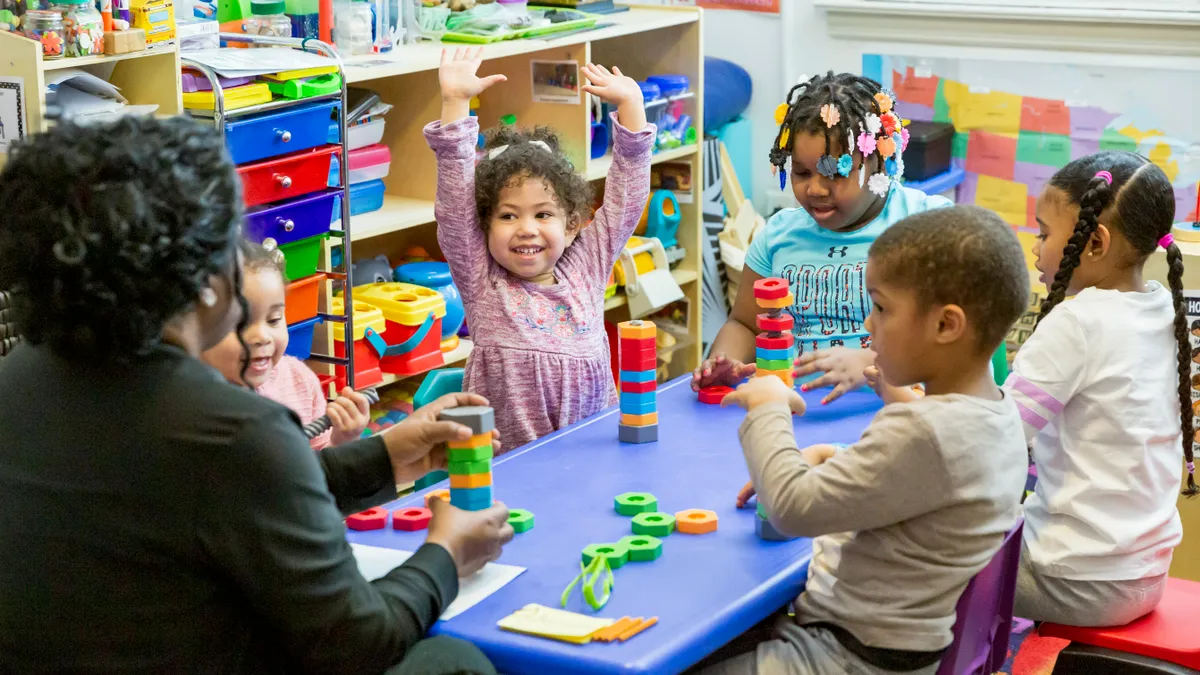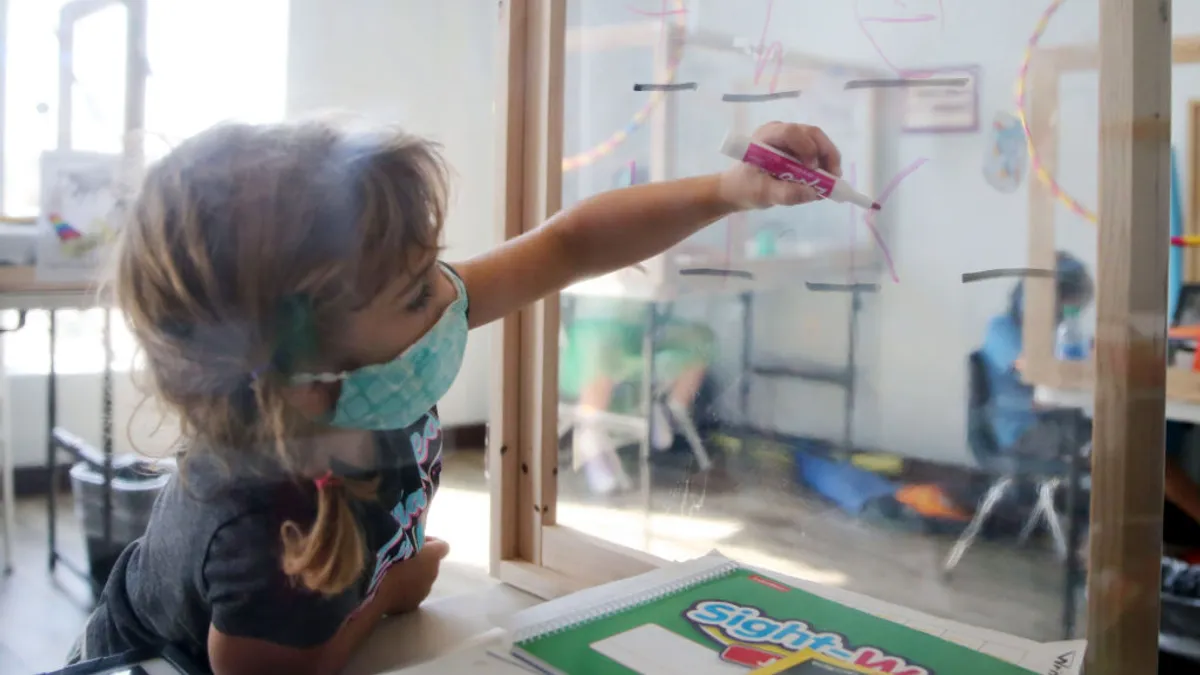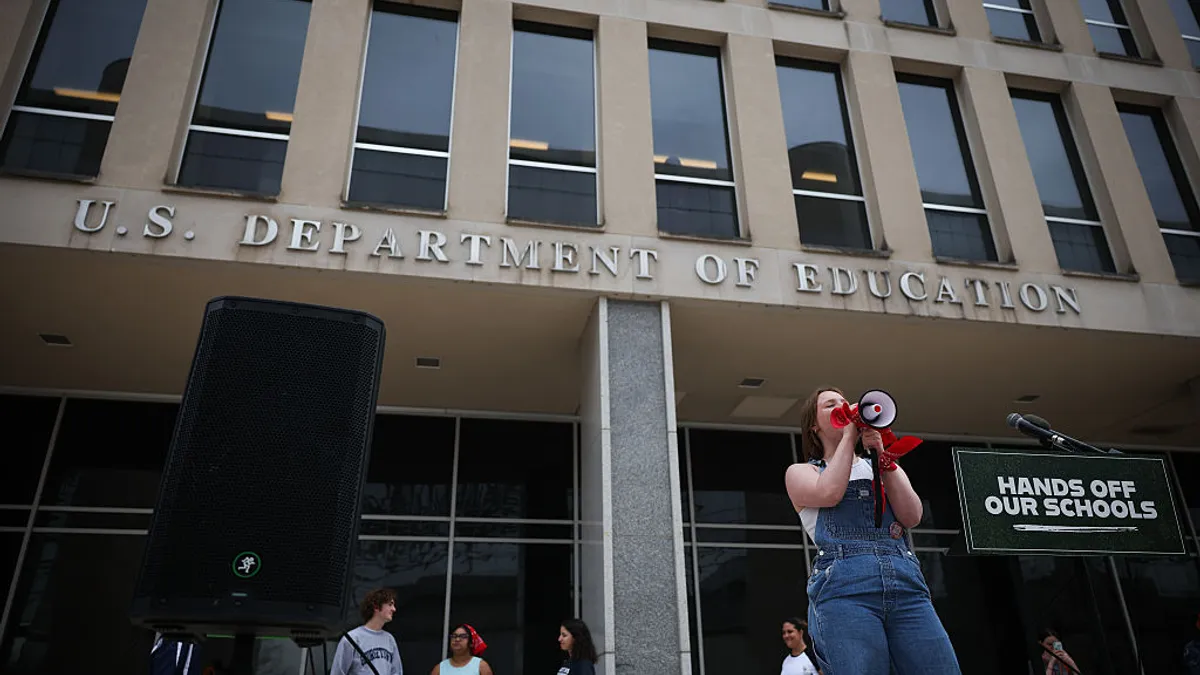Kindergarten students, who did not enroll or attend schooling in noticeable numbers during the pandemic, are expected to have larger participation rates next school year, and school systems are planning now to meet these young learners' needs.
In fact, some education experts are predicting a “kindergarten bubble” of 4-, 5- and 6-year-olds who may be more unprepared for formal schooling compared to past years’ cohorts, and who will come to school with a wider range of skills based on their COVID-19 academic and social experiences.
“As we're thinking about resources next year and definitely want to attend to needs academic, social, emotional… This new kind of bubble, if you will, is likely to be a larger and more diverse class,” said Beth Tarasawa, executive vice president of research for NWEA, who co-authored a report released Monday about how schools can prepare for the kindergarten class of 2021.
Indeed, in anticipating sizable kindergarten and 1st grade classes, school administrators are currently reviewing assessment procedures, academic and social supports, staffing needs, and classroom spaces.
For example, the Hamilton Township School District in New Jersey is considering adding portable classrooms at five of the district’s 17 elementary schools, in part because of anticipation of larger kindergarten and 1st grade classes, said Superintendent Scott Rocco. This school year, there were a total of 745 kindergartners, 62 fewer than the year before.
“We're rolling enrollment, but if I’d venture a guess right now, we probably have over 700 kids enrolled for next year already, which would outpace where we’ve been at this point, at any time,” he said.
‘A crystal ball moment’
Typically, preschool and kindergarten are filled with hands-on, play-based activities that not only support early reading and math skills, but also introduce vital social and emotional skills such as sharing, turn-taking and resolving conflicts, according to early childhood education experts.
But when the pandemic forced those experiences online unnaturally, many families decided to delay enrollment or attendance in formal schooling. In fact, preschool and kindergarten enrollment dipped by sizable numbers in some places.
State-funded Pre-K programs report enrollment declines that ranged from 15% to 41%, according to the National Institute for Early Education Research. In Texas, kindergarten enrollment was down 6% in October 2020, compared to October 2019, according to the Texas Education Agency. Pre-K enrollment was down 22%. Additionally, an unaudited December report from Michigan’s Center for Education and Performance Information found total enrollment fell by 53,000 students from the fall of 2020, compared to the fall of 2019. Around 13,000 of those students were from the anticipated kindergarten class.
“Some children will benefit from the one-year delay in kindergarten, those who are a little younger and/or a little less ready to start school. Many others will not,” said a Michigan Department of Education release about the preliminary enrollment numbers. “Parent choice in a pandemic to wait a year until children can get a more complete, less staccato experience in public schools will serve well some children in some schools and less well other children in other schools. Still, these children aren’t missing: their parents have delayed their kindergarten entry in a pandemic, as is their right.”
Predicting this fall’s kindergarten cohort depends on early enrollment data analysis and other factors such as trends in regional mobility and birthrates. Some families could decide to delay the kindergarten year as long as COVID-19 is a threat. Although vaccines will be available to most adults this spring and summer, young children likely won’t have access to a vaccine until later this year or early in 2022, said Dr. Anthony Fauci, director of the U.S. National Institute of Allergy and Infectious Diseases, on "Meet The Press" in February.
And while kindergarten enrollment is ongoing for Fall 2021 and some places are seeing increased interest, others, such as New York City Public Schools, are reporting decreases in applications, according to Chalkbeat.
“This is a little bit of a crystal ball moment,” Tarasawa said of trying to predict incoming kindergarten class sizes. Most states don’t require kindergarten attendance, but many require districts to offer half or full-day kindergarten programs.
Greater age gaps, skill disparities
Being ready not only for more kindergarten students, but also for the academic and non-academic needs of young children who may have had limited exposure to early learning or socialization during the pandemic, is critical for district, school and classroom staff, the NWEA report said.
The organization suggests taking the following factors into consideration.
-
Respond to greater age differences: Students whose families may have delayed their entry into kindergarten during the pandemic will enter kindergarten or 1st grade, depending on age requirements. This will lead to expanded age differences in kindergarten and 1st grade classrooms as first-time and younger attendees will be in the same classes as students who could be more than a year older.
Schools and classroom teachers should make the time and effort early in the school year to build positive relationships between staff and students, and between classmates. ”Kindergarten teachers play a critical role in cultivating students’ love of learning early in their educational career, and it all starts with relationships,” the NWEA report said. -
Understand the wider skill disparities: Larger age gaps may also correspond with greater disparities in levels of kindergarten preparedness, as younger students may not have had as much exposure to early learning experiences compared to their older peers. Additionally, economic disparities could leave some historically marginalized students to have lower reading and math skills compared to more advantaged classmates who had private preschool or tutoring lessons during the pandemic.
Collecting data to determine readiness for instruction at the beginning of the year can help identify unfinished learning needs for individual students, as well as guide learning activities that can help students work toward mastery levels, the report recommends. Additionally, small, flexible grouping for instruction and practice can help teachers manage a variety of learning needs.
Tarasawa also recommends schools try to place effective teachers experienced with supporting diverse learners in kindergarten classrooms and to add paraprofessionals and other staff, such as counselors. -
Use summer to kick-start kindergarten: As many school districts look for opportunities to recover lost instructional time, some are expanding summer learning programs even for the youngest students. These programs can boost academic readiness, as well as help students who have never been in a formal education setting build their social skills, gain confidence and become excited for the school year, the report said.
Hedy Chang, director of Attendance Works, said federal stimulus funding can help schools provide robust summer programs and teacher home visits — virtually or socially distanced — as a way to lay the groundwork for strong parent-school relationships, as well as to ease the transition to school for young students. These practices can contribute to strong school attendance rates, Chang said. -
Make data-driven decisions: Don’t assume older students will be prepared for kindergarten and that younger ones won’t. Research shows the relationship between age gaps and learning is not clear cut. Research also shows kindergarten classroom age ranges can have benefits for both younger and older students, the NWEA report said.
Using data to scaffold for learning access or to extend beyond grade-level expectations can help educators meet the needs of a diverse group of students. Schools should also consider one-to-one conferences for students and families, either formally or informally, to better understand a young student’s adjustment to kindergarten, the report recommends.
“We have some time or some runway before we start the 2021-22 school year, so our hope was that, you know, let's purposefully think about those resources that can be an additional pair of professionals or what other social-emotional support can we bring — particularly on those early learners, because those foundational years are so critical,” Tarasawa said.





















